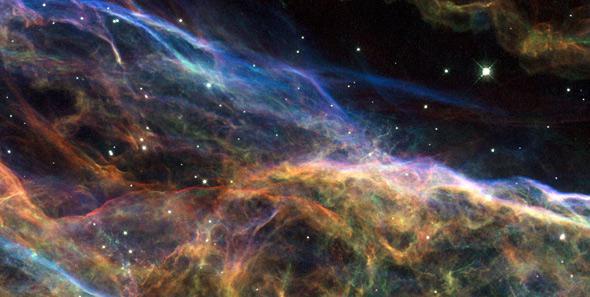No one knows exactly when – maybe it was 5000 years ago, maybe 10,000 – a young star exploded.
It suffered through a fitful life. Born with something like 40 times the mass of the Sun, it led its life a thousand times faster than our more modest star. Hydrogen fused to helium in its core, and then helium to carbon, and carbon to neon… while the vast interplay of light and force drove wave after wave of dense shells of matters off its surface.
Eventually, time ran out. The fuel in the core gone, it collapsed, sending out a fleet of ghostly neutrinos and a shock wave so gigantic that it crushes the human mind to dust. Septillions of tons of matter exploded outward, and a supernova was born.
The gas that was once the core of a sun screamed out at a fraction of light, but something was in the way– the octillions of tons of gas shed earlier by the star, as well as gas and dust left over from its birth just a million or two years before. The two collided, and countless shock waves were generated. The matter surrounding the exploded star was compressed, rammed, and sculpted into thin shells and ribbons. This material, even compressed, is ethereally thin by human standards; seen face-on, the sheets of gas are faint and diffuse, but when they present their edges to us, we see them as sharp filaments, like a soap bubble’s edge. The material glows with the same basic physical principles as a neon sign: sulfur, oxygen, and hydrogen contribute their own unique fingerprints to the eerie luminescence of the gas.
And so we see the aftermath of the cosmic catastrophe that is the Veil Nebula, an arcing structure that has, since the explosion, expanded to a diameter a full six times larger than the Moon in the sky, even though it is something like 36 billion times farther away. It’s located in the constellation of Cygnus, the Swan, high in the summer sky for northern hemisphere observers– but you’ll never see it with the naked eye. Millennia have faded its glory, even though it probably shone almost as bright as the Moon when its light first touched Earth. Now, though, you need a big telescope and dark skies to see it at all.
The image above is newly released from the Hubble Space Telescope, which can resolve fine details in the nebular structure. We understand a huge amount about how stars explode, and what happens in the subsequent centuries, but there is also much we don’t know. Images like this one and the others released with it give us a forensic insight on the event that destroyed an entire star. We learn more about the nuclear fires at its heart, the subsequent alchemy of the expanding debris, and the effects of depositing unimaginable energies into its environment.
But it’s also very pretty. There’s a lot to be said for that as well.
